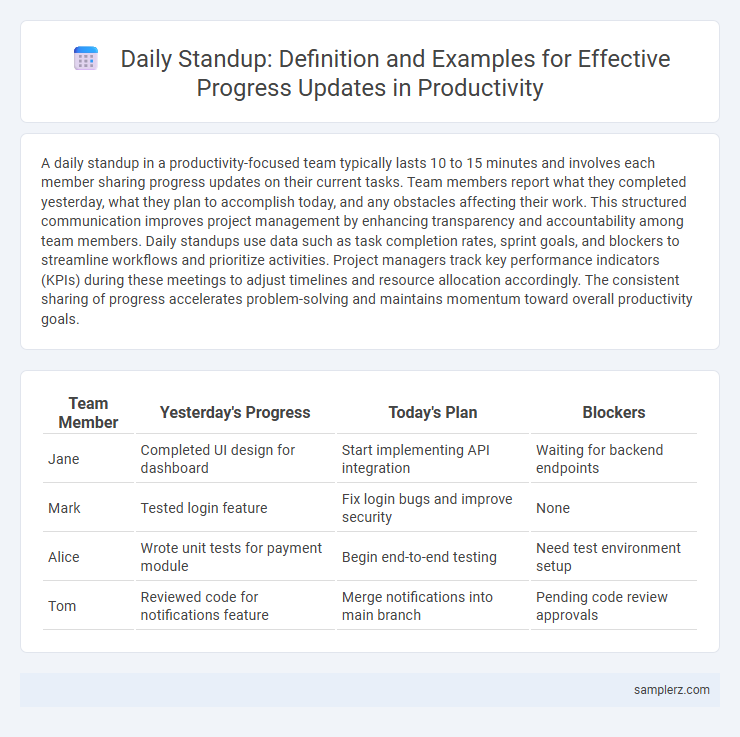A daily standup in a productivity-focused team typically lasts 10 to 15 minutes and involves each member sharing progress updates on their current tasks. Team members report what they completed yesterday, what they plan to accomplish today, and any obstacles affecting their work. This structured communication improves project management by enhancing transparency and accountability among team members. Daily standups use data such as task completion rates, sprint goals, and blockers to streamline workflows and prioritize activities. Project managers track key performance indicators (KPIs) during these meetings to adjust timelines and resource allocation accordingly. The consistent sharing of progress accelerates problem-solving and maintains momentum toward overall productivity goals.
Table of Comparison
| Team Member | Yesterday's Progress | Today's Plan | Blockers |
|---|---|---|---|
| Jane | Completed UI design for dashboard | Start implementing API integration | Waiting for backend endpoints |
| Mark | Tested login feature | Fix login bugs and improve security | None |
| Alice | Wrote unit tests for payment module | Begin end-to-end testing | Need test environment setup |
| Tom | Reviewed code for notifications feature | Merge notifications into main branch | Pending code review approvals |
Key Elements of a Daily Standup Progress Update
Daily standup progress updates emphasize three key elements: concise reporting of completed tasks, outlining current priorities, and identifying blockers or challenges. Team members share specific outcomes from the previous day, clarify goals for the current session, and highlight any obstacles requiring assistance. This structured approach enhances transparency, accelerates problem-solving, and boosts overall team productivity.
Sample Daily Standup Dialogue for Tracking Progress
Team members share concise updates during daily standups, reporting completed tasks, ongoing work, and obstacles to ensure transparency and alignment. For example, one member may say, "Yesterday I finished the client report, today I'm starting the data analysis, but I'm facing delays due to missing information." This structured dialogue enables quick identification of bottlenecks and prioritization of tasks for enhanced team productivity.
Effective Ways to Share Progress in Standup Meetings
During daily standup meetings, team members share concise progress updates by highlighting completed tasks, current priorities, and any blockers impacting workflow. Using clear, actionable language and focusing on key deliverables enhances communication efficiency and aligns team efforts. Visual aids like task boards or digital tools further optimize transparency and accountability in progress sharing.
Example Standup Update Focused on Task Status
Completed the API integration for the user authentication module, resolving previous sprint blockers related to endpoint failures. Currently addressing UI responsiveness issues reported during cross-device testing to enhance user experience. Planning to initiate performance optimization on the database queries by end of day to reduce load times by 20%.
Reporting Roadblocks During Daily Standups
During daily standups, team members report roadblocks by clearly stating specific issues hindering task progress, such as software bugs, resource shortages, or unclear requirements. This transparent communication enables prompt intervention and reallocation of resources to maintain productivity momentum. Effective reporting of roadblocks ensures continuous workflow and timely project completion by addressing obstacles as they arise.
How to Articulate Team Progress in Standup Format
Team members concisely report completed tasks, current focus areas, and any blockers hindering progress during daily standups. Using clear, specific language such as "Completed the API integration for the payment module," "Currently debugging the user authentication issue," and "Waiting on design assets to finalize the homepage layout" enhances transparency. Structuring updates around goals, achievements, and obstacles ensures actionable insights and streamlined collaboration.
Structuring Your Progress Updates in Daily Meetings
Daily standups should highlight key achievements, current tasks, and immediate challenges to maintain clarity and momentum. Structuring progress updates using concise, specific metrics like completed deliverables, percentage of task completion, and pending blockers enhances team alignment. Emphasizing time-bound goals and clear next steps fosters accountability and streamlines workflow during these brief meetings.
Best Practices: Progress Updates in Agile Standups
Daily standups in Agile teams should feature concise progress updates, clearly stating completed tasks, ongoing work, and immediate roadblocks in under a minute per participant. Emphasizing transparency and accountability fosters team alignment, enabling quick adjustments and continuous delivery. Using time-boxed updates and visual aids like task boards enhances clarity and drives productivity.
Real-Life Scenarios: Progress Updates in Action
Daily standups provide concise progress updates by having team members share completed tasks, ongoing efforts, and obstacles encountered, ensuring alignment and timely problem-solving. For example, a software development team might report fixing specific bugs, current sprint goals, and any technical blockers limiting feature deployment. This real-life practice enhances productivity by promoting transparency, accountability, and swift resolution within agile workflows.
Common Mistakes in Giving Standup Progress Updates
Common mistakes in daily standup progress updates include vague status reports that lack specific accomplishments or blockers, leading to unclear team alignment. Overloading updates with excessive detail can waste valuable meeting time and obscure key priorities. Effective standups emphasize concise, actionable information that highlights progress and immediate challenges to maintain productivity and collaboration.

example of daily standup in progress update Infographic
 samplerz.com
samplerz.com